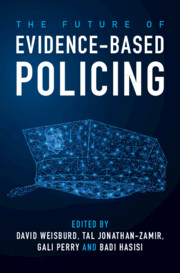Book contents
- The Future of Evidence-Based Policing
- The Future of Evidence-Based Policing
- Copyright page
- Contents
- Figures
- Tables
- Contributors
- Editors
- 1 The Future of Evidence-Based Policing
- Part I Taking Stock of Evidence-Based Policing
- Part II The Evidence for Evidence-Based Policing
- Part III Innovations in Tools of Evaluation and Assessment
- Part IV Challenges to the Implementation of Evidence-Based Policing
- Part V The Practitioner’s Perspective
- 14 The Role of the “Super Evidence Cop” in Evidence-Based Policing
- 15 Looking Back on the Challenges to Evidence-Based Policing
- 16 Support for Evidence-Based Policing at the National Level
- 17 Conclusions
- Index
- References
14 - The Role of the “Super Evidence Cop” in Evidence-Based Policing
The Israeli Case
from Part V - The Practitioner’s Perspective
Published online by Cambridge University Press: 01 June 2023
- The Future of Evidence-Based Policing
- The Future of Evidence-Based Policing
- Copyright page
- Contents
- Figures
- Tables
- Contributors
- Editors
- 1 The Future of Evidence-Based Policing
- Part I Taking Stock of Evidence-Based Policing
- Part II The Evidence for Evidence-Based Policing
- Part III Innovations in Tools of Evaluation and Assessment
- Part IV Challenges to the Implementation of Evidence-Based Policing
- Part V The Practitioner’s Perspective
- 14 The Role of the “Super Evidence Cop” in Evidence-Based Policing
- 15 Looking Back on the Challenges to Evidence-Based Policing
- 16 Support for Evidence-Based Policing at the National Level
- 17 Conclusions
- Index
- References
Summary
The road to evidence-based policing (EBP) is often difficult, and the Israeli experience has been no different. To overcome barriers and more effectively facilitate and ensure translation of research into practice, Sherman (1998) suggested the role of the “evidence cop.” The evidence cop, whether a sworn officer or an outside academic, is assigned responsibility for overseeing the implementation of EBP. Success in achieving the ambitious objectives of EBP is likely to vary considerably due to the likelihood that the officers will be perceived with suspicion, undermining their authority. Our analysis takes a historical perspective, focusing on two distinct attempts at strategic reform in the Israel Police (IP). The first took place in the mid-1990s under Commissioner Hefetz, while the first author was a senior figure in the IP and benefits from first-hand knowledge of the attempt to integrate EBP. The second attempt took place in the recent years under Commissioner Alsheich. The reason Alsheich was able to achieve considerable success in his substantial EBP reform in the police force, while Hefetz and many commissioners around the world were less successful, lies, in our opinion, in the fact that Alsheich himself was the “evidence cop”, leading the process as a “super evidence cop.”
Keywords
- Type
- Chapter
- Information
- The Future of Evidence-Based Policing , pp. 273 - 291Publisher: Cambridge University PressPrint publication year: 2023

